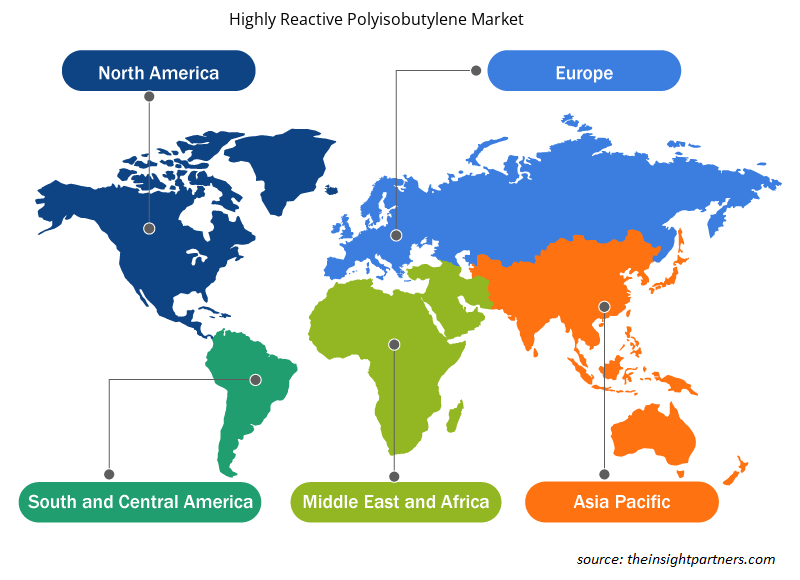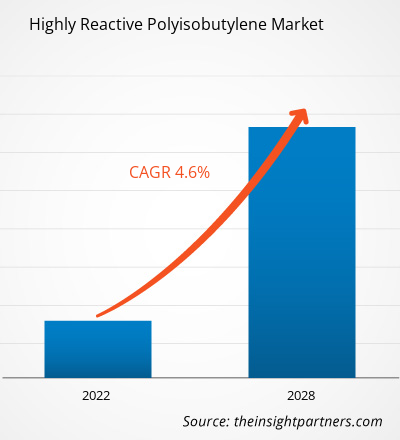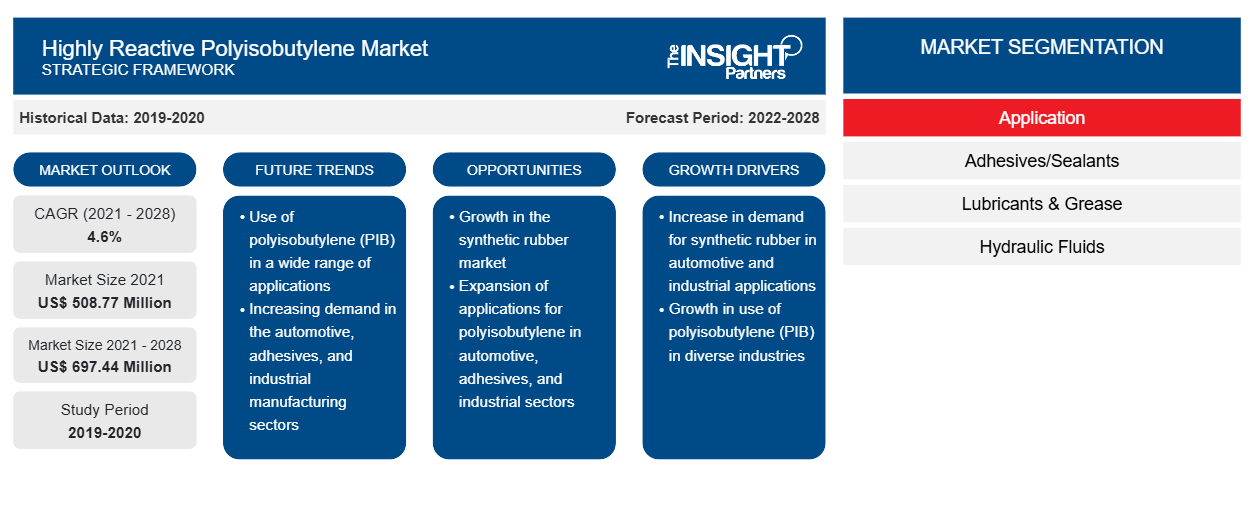高反应性聚异丁烯市场规模预计将从 2021 年的 5.0877 亿美元增至 2028 年的 6.9744 亿美元;预计 2021 年至 2028 年的复合年增长率为 4.6%。
高活性聚异丁烯 (HR-PIB) 是生产高性能燃料和润滑油添加剂(如发动机油分散剂或燃料清洁剂)的重要中间体。高性能润滑油添加剂可实现更省油的发动机设计。
2020 年,亚太地区占据高活性聚异丁烯市场的最大收入份额。润滑油和润滑脂部门是亚太地区 HR-PIB 的最大消费者。该地区汽车行业的蓬勃发展推动了对液压油和润滑剂的需求,从而推动了对 HR-PIB 的需求。此外,亚太地区工业化和建筑业的增长推动了对相关制造设施机械和设备的需求。
定制此报告以满足您的需求
您可以免费定制任何报告,包括本报告的部分内容、国家级分析、Excel 数据包,以及为初创企业和大学提供优惠和折扣
- 获取此报告的关键市场趋势。这个免费样品将包括数据分析,从市场趋势到估计和预测。
COVID-19 疫情对高反应性聚异丁烯市场的影响
2020 年,由于国家和国际边界关闭导致供应链中断,各行业不得不放慢运营速度,导致对 HR-PIB 的需求下降。由于各国政府当局对工作场所员工人数和交通施加限制,疫情导致制造流程中断,给员工往返工作地点带来挑战。HR-PIB 主要用于高性能燃料和润滑油添加剂的制造。各行业对燃料的需求下降阻碍了燃料添加剂的消费,最终阻碍了 HR-PIB 的销售。然而,随着 2021 年经济开始复苏,对 HR-PIB 的需求也开始逐渐上升。
市场洞察
HR-PIB 在高性能燃料和润滑油添加剂生产中的应用日益广泛
HR-PIB 是一种重要的中间体,可用于生产高性能燃料和 is an important intermediate that finds application in the production of high-performance fuel and 润滑油添加剂。由于其高反应性,在添加剂生产中它比传统的聚异丁烯更受欢迎。润滑油添加剂的主要作用是改善基础油在不同操作条件下的性能。此外,高性能润滑油添加剂支持更省油的发动机设计。分散剂是一种润滑油添加剂,有助于防止在关键表面形成油泥、清漆和其他沉积物。汽车发动机油分散剂的工业合成对 HR-PIB 的需求正在增长。美国、欧洲和亚太地区拥有强大的添加剂制造基地,使它们成为 HR-PIB 的主要消费者。因此,HR-PIB 在高性能燃料和润滑油添加剂制造中的使用越来越多,推动了市场增长。polyisobutylene in the production of additives. The main function of lubricant additives is to improve the properties of the base stock under different operating conditions. Moreover, high-performance lubricant additives support more fuel-efficient engine designs. Dispersants are lubricant additives that help prevent sludge, varnish, and other deposit formation on critical surfaces. The demand for HR-PIB is growing in the industrial synthesis of dispersants for automotive engine oils. The presence of strong additive manufacturing bases in the US, Europe, and Asia Pacific makes them prime consumers of HR-PIB. Hence, the increasing use of HR-PIB in the manufacturing of high-performance fuel and lubricant additives boosts the market growth.
应用程序洞察
根据应用,高反应性聚异丁烯市场细分为粘合剂/密封剂、润滑剂和润滑脂、液压油、金属加工液等。 润滑剂和润滑脂部分在 2020 年占据了最大的市场份额。 发动机油、变速箱油、齿轮油、润滑脂和压缩机油等润滑剂在汽车、飞机、船舶和机械行业中消耗量很大。 HR-PIB 有助于提高润滑剂的整体性能。polyisobutylene market has been segmented into adhesives/sealants, lubricants & grease, hydraulic fluids, metal working fluids, and others. The lubricants & grease segment held the largest market share in 2020. Lubricants such as engine oils, transmission oils, gear oils, greases, and compressor oils are highly consumed in the automotive, aircraft, marine, and machinery industries. HR-PIB helps enhance the overall performance of lubricants.
TPC 集团、RB PRODUCTS INC.、BASF PETRONAS Chemicals Sdn. Bhd、山东鸿瑞新材料科技有限公司、大林株式会社、雪佛龙公司、路博润公司、KEMAT 聚丁烯、潍坊滨海石油化工有限公司和 Nelson Brothers Incorporated 是高活性聚异丁烯市场的主要市场参与者。高活性聚异丁烯市场的参与者高度专注于开发高质量和创新的产品以满足客户的要求。 Group; RB PRODUCTS INC.; BASF PETRONAS Chemicals Sdn. Bhd; Shandong Hongrui New Material Technology Co., Ltd; Daelim Co., Ltd.; Chevron Corporation; The Lubrizol Corporation; KEMAT Polybutenes; Weifang Binhai Petro-chem Co., Ltd.; and Nelson Brothers Incorporated are among the key market players in the highly reactive polyisobutylene market. Players operating in the highly reactive polyisobutylene market are highly focused on the development of high-quality and innovative products to meet the customer’s requirements.
高反应性聚异丁烯市场区域洞察Polyisobutylene Market Regional Insights
Insight Partners 的分析师已详细解释了预测期内影响高反应性聚异丁烯市场的区域趋势和因素。本节还讨论了北美、欧洲、亚太地区、中东和非洲以及南美和中美洲的高反应性聚异丁烯市场细分和地理位置。

- 获取高反应性聚异丁烯市场的区域特定数据
高反应性聚异丁烯市场报告范围
| 报告属性 | 细节 |
|---|---|
| 2021 年市场规模 | 5.0877亿美元 |
| 2028 年市场规模 | 6.9744亿美元 |
| 全球复合年增长率(2021 - 2028) | 4.6% |
| 史料 | 2019-2020 |
| 预测期 | 2022-2028 |
| 涵盖的领域 | 按应用
|
| 覆盖地区和国家 | 北美
|
| 市场领导者和主要公司简介 |
|
高反应性聚异丁烯市场参与者密度:了解其对业务动态的影响
高反应性聚异丁烯市场正在快速增长,这得益于终端用户需求的不断增长,而这些需求又源于消费者偏好的不断变化、技术进步以及对产品优势的认识不断提高等因素。随着需求的增加,企业正在扩大其产品范围,进行创新以满足消费者的需求,并利用新兴趋势,从而进一步推动市场增长。
市场参与者密度是指在特定市场或行业内运营的企业或公司的分布情况。它表明在给定市场空间中,相对于其规模或总市场价值,有多少竞争对手(市场参与者)存在。
在高反应性聚异丁烯市场运营的主要公司有:
- TPC集团
- RB 产品公司
- 巴斯夫马来西亚国家石油化工有限公司
- 山东鸿瑞新材料科技有限公司
- 大林株式会社
免责声明:上面列出的公司没有按照任何特定顺序排列。

- 获取高反应性聚异丁烯市场顶级关键参与者概览
报告亮点
- 高反应性聚异丁烯行业的进步趋势,帮助参与者制定有效的长期战略
- 公司为确保发达市场和发展中市场的增长而采取的业务增长战略
- 2019 年至 2028 年高反应性聚异丁烯市场定量分析
- 全球 HR-PIB 需求预测
- 波特五力分析说明了行业内买家和供应商的效力
- 了解竞争市场状况的最新发展
- 市场趋势和前景,以及推动和抑制高反应性聚异丁烯市场增长的因素
- 通过强调支撑商业利益的市场策略来协助决策过程
- 不同节点高活性聚异丁烯市场规模
- 市场详细概述和细分,以及 HR-PIB 行业动态
- 各地区高活性聚异丁烯市场规模及增长潜力
高反应性聚异丁烯市场
应用
- 粘合剂/密封剂
- 润滑剂和油脂
- 液压油
- 金属加工液
- 其他的
公司简介
- TPC集团
- RB 产品公司
- 巴斯夫马来西亚国家石油化工有限公司
- 山东鸿瑞新材料科技有限公司
- 大林株式会社
- 雪佛龙公司
- 路博润公司
- KEMAT 聚丁烯
- 潍坊滨海石油化工有限公司
- 纳尔逊兄弟公司
- 历史分析(2 年)、基准年、预测(7 年)及复合年增长率
- PEST和SWOT分析
- 市场规模、价值/数量 - 全球、区域、国家
- 行业和竞争格局
- Excel 数据集
近期报告
客户评价
购买理由
- 明智的决策
- 了解市场动态
- 竞争分析
- 客户洞察
- 市场预测
- 风险规避
- 战略规划
- 投资论证
- 识别新兴市场
- 优化营销策略
- 提升运营效率
- 顺应监管趋势





















 获取免费样品 - 高反应性聚异丁烯市场
获取免费样品 - 高反应性聚异丁烯市场